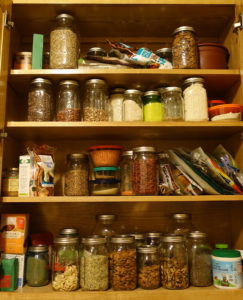
Below is a list of foods that can get you through a wide variety of plant-based eating. You can make nearly any type of cuisine with these ingredients, and you can stock up on them so that you only need to purchase items like fresh fruits, vegetables, greens, herbs and sprouts on a routine basis. Shop seasonal and local as much as possible, and check out the Environmental Working Group’s “dirty dozen” list to identify which foods you should try to buy organic, if your budget allows for it.
-whole grains (quinoa, buckwheat groats, black rice, wild rice, brown rice, steel-cut oats)
-legumes (chickpeas, lentils, peas, mung beans, black beans, kidney beans, pinto beans, navy beans, soybeans)
-whole grain or legume pastas, noodles
-flours (oat, almond, chickpea, spelt, casava)
-nuts and seeds (almonds, walnuts, brazil nuts, hempseed, flaxseed, pumpkin seeds)
-dried fruit (goji berries, dates, figs, raisins)
-nutmilks
-coconut (water, milk, cream, shredded, powdered)
-seaweed
-canned tomatoes, tomato paste
-popcorn kernels
-miso (try chickpea)
-wasabi powder
-nutritional yeast
-mustard
-apple cider vinegar, white wine vinegar, red wine vinegar, balsamic vinegar
-soy sauce (look for low-sodium versions, or alternatives like liquid aminos)
-hot sauce (try a fermented, probiotic version), tabasco sauce
-olives
-raw cacao powder
-teas (green, black, herbal)
-baking powder and baking soda
-arrowroot powder
-spices: herbs de provence, basil, oregano, thyme, rosemary, sage, dill weed, sea salt, pepper, cayenne, paprika, chipotle pepper powder, crushed red chili pepper flakes, chili powder, garlic powder, ginger powder, bay leaves, whole cumin, ground cumin, ground coriander, garam masala, brown mustard seeds, onion powder, turmeric, curry powder, kelp granules, cinnamon powder, whole cloves, cardamom seeds
-frozen foods: berries and other fruits, leafy greens and other vegetables, fermented and/or sprouted breads, tempeh, tofu

